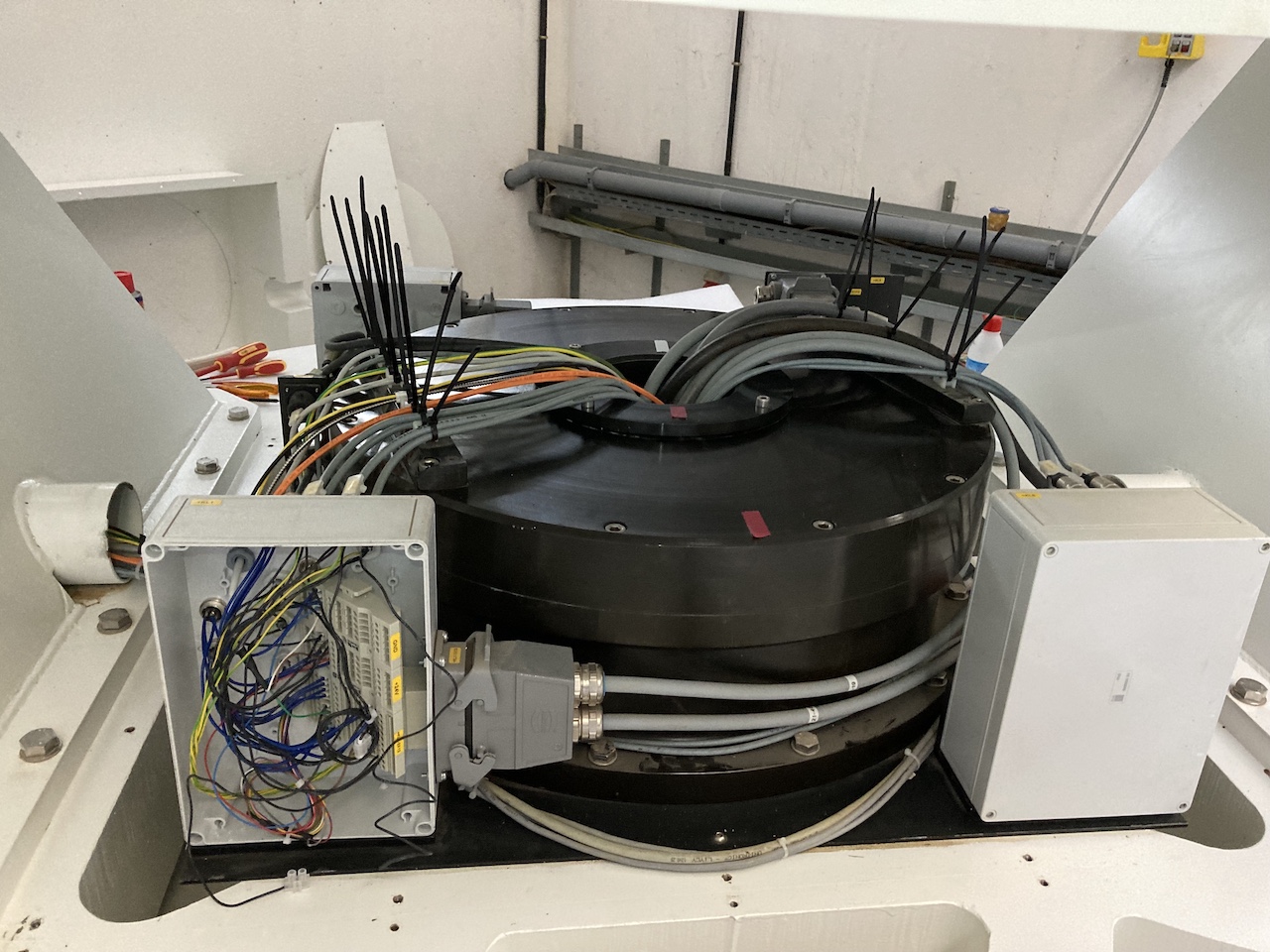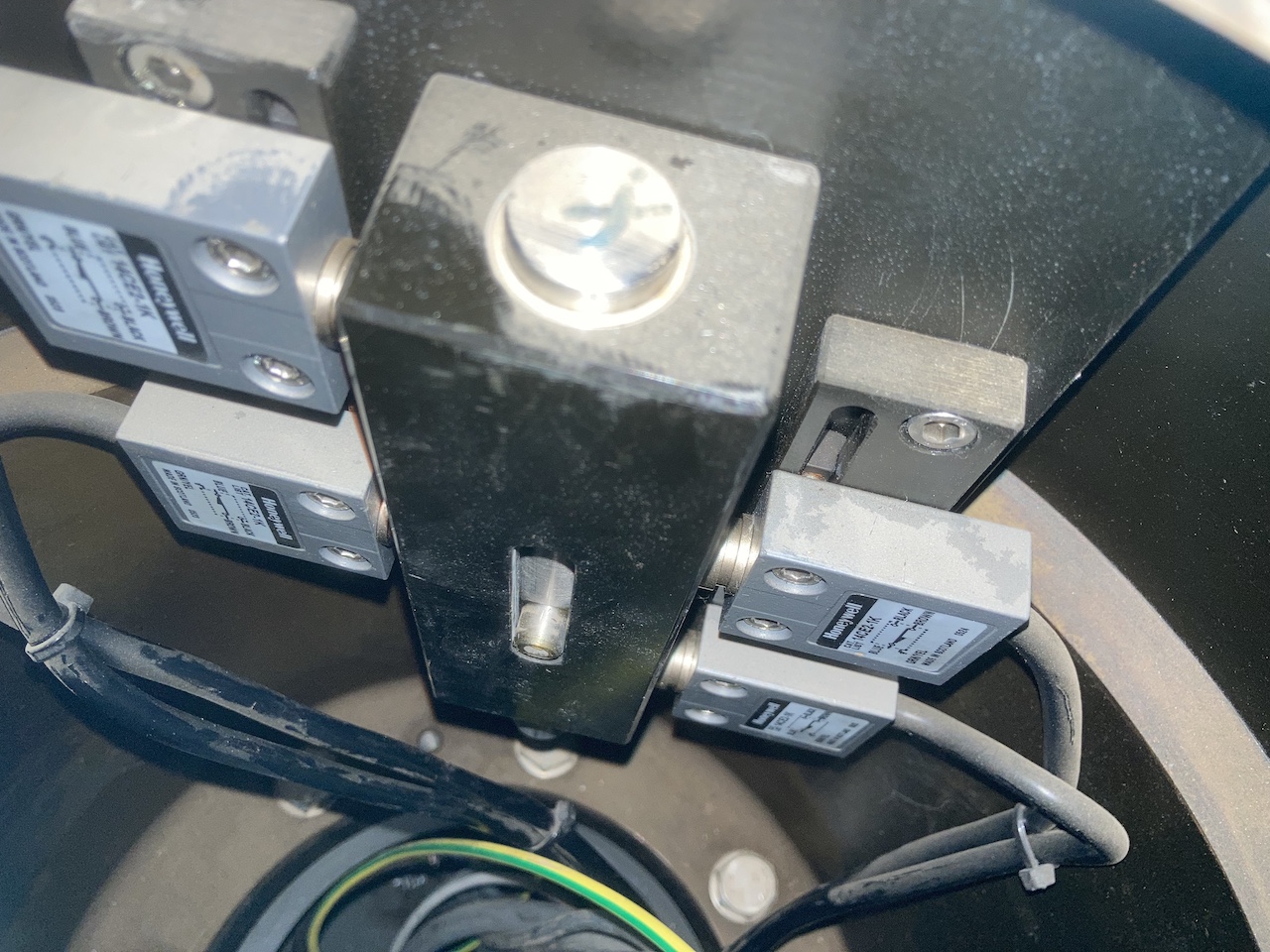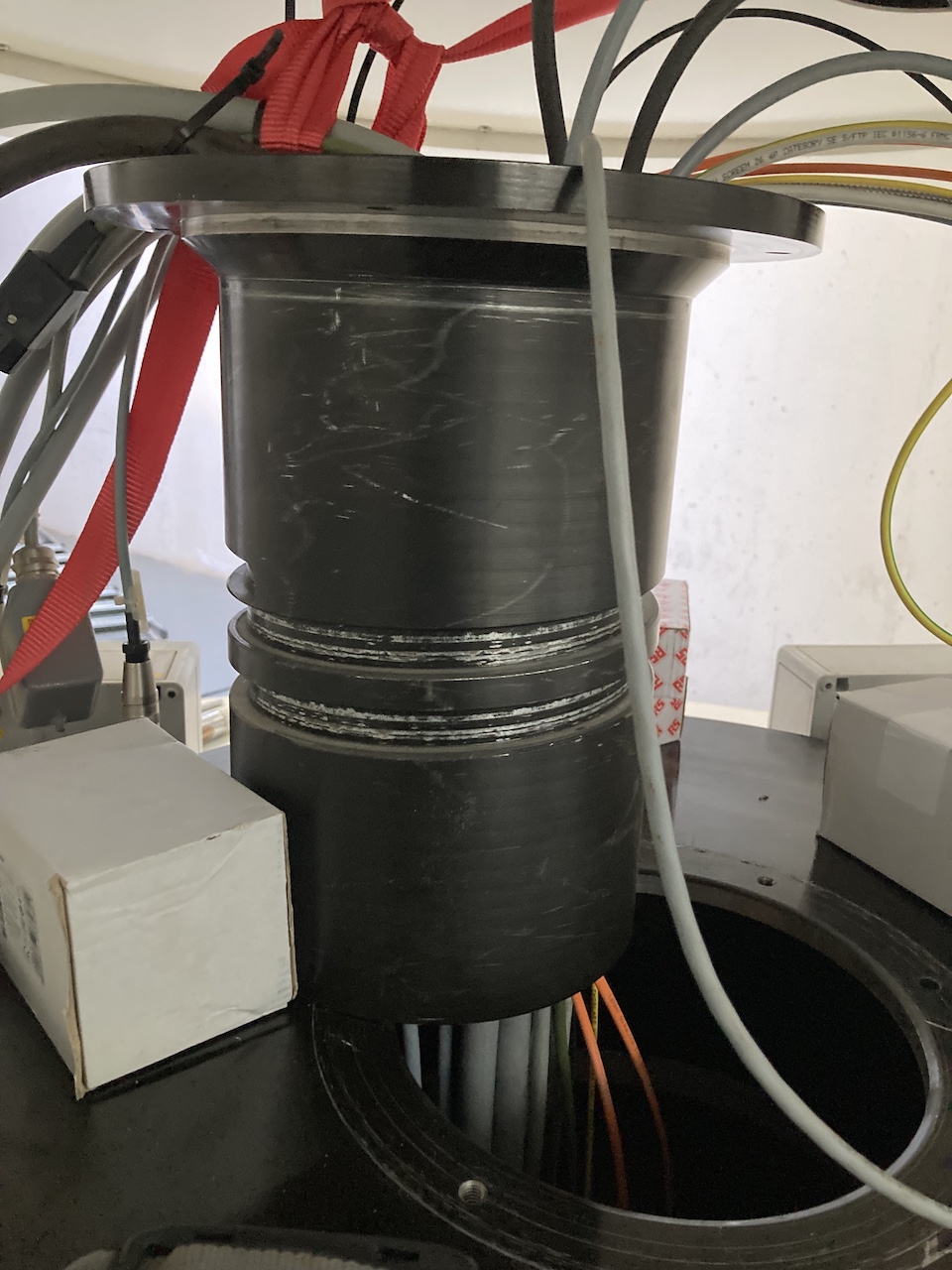TELESCOPES¶
Bedienungsanleitung Handsteuerung¶
Für alle nachfolgenden Punkte ist es notwendig, dass die Leistung auf “ein” steht und der Wahlschalter der Handsteuerung auf “Manual”.
Klappe 1 (bei RoboTel und STELLA-2 nicht vorhanden)
Klappe 2
Klappe 3
Nasmyth/M3: Enable/Reset öffnet und schließt Bremse
Fokus: Enable/Reset öffnet und schließt Bremse
Derotator
Elevation
Azimut
Dome
Filterrad (noch nicht implementiert)
reserviert
reserviert
reserviert
reserviert
Hydraulik: Enable = Hydraulik start; Reset = Hydraulik stop; Auf = Bremse auf; Ab = Bremse zu: Links zeigt Betrieb der Vorlaufpumpe an; Rechts = Betrieb Rücklauf
Vor Programm 7 oder 8 Bremse lösen! In Programmen 1-9 löscht “Reset” etwaige Motorfehler. (Fehleranzeige an Handsteuerung defekt)
STELLA Troubleshooting¶
Quickstart¶
Most problems can be noticed and solved using just one terminal on archive. Use the following command (NOTE: will change in the near future) :: arto/show_status.sh to get an overview. For seeing all logfiles at the same time each in it’s own window :: arto/openall.sh
There is another possibility to get up a GUI and have some control on the light and webcam inside the building: Start with java stella.jview.JOffLimit ‘’‘wait some time’‘’ There are two, wrongly-labeled buttons STELLA and WIFSIP. (STELLA shows STELLA-1, but everything else in the left part refers to SES). Pressing one of these button updates the webcam composite image of the telescope. Turn on the light with the button to the left of STELLA, if Lights off. Again, wait some time for the button to get active. Otherwise, you see green buttons, yellow and sometimes red ones, that tell you about some conditions that are out of specks.
Is the MasterMind doing fine? type m1tail on archive or m2tail on wifsip and watch the output for a bit. Either the last line is ‘no new targets after…’ or ‘resetting exposure time…’ Is the telescope server fine? Type t1tail or t2tail and look for unusual messages.
Thing to watch out for, most probable problems:
Is the master-mind running? It stops after a fatal error.
Telescope hangs: use vnc or x-via-ssh to manually reset the errors. Note that Pilar is by default running without gui. You need to restart Pilar without the no-gui option. Use the startup-script in ~/bin to start it with the correct options again. You need to restart the telescope server stella-telescope1-start.sh afterwards!
There is also a command line option doing similar things::
TA (aliased to java stella.telescope.TelescopeAccess) -m (put telescope in manual mode, only then the following commands are allowed) TA -err (get list of errors currently on) TA -clear (clears all non-fatal errors. Fatal errors are cleared only on the first try (or after 1-24 hours). Check the log file, if successful). TA -wipe (wipes out the history of errors, meaning that now a TA -clear will try to clear a fatal condition ‘‘once’’.) TA -a (put the telescope back into automatic control)
Other things possible in manual mode (do a TA without anything to get a list)::
TA -init (initialize the telescope, if not on) TA -park (Parks the telescope - power off) TA -azalt (moves the telescope to a position. Good thing to check after a wipe/clear of fatal errors)
Filter wheel is stuck: reset the power to the ag-unit, restart the java-guider-server, and then restart the MasterMind. This error does usually not occur any more.
CCD controller hangs: reset the ccd controller, possibly also either restart the ses-server on the ses computer or reboot the ses computer
What where¶
All computers involved run a rmiregistry server to handle communications.
archive (161.72.132.71)¶
This hosts the main STELLA SQL database. It also operates the ‘’‘second’‘’ telescope, STELLA-2 (the one in the East part of the building, no M2/M3). All startup-scripts have a ‘‘2’’ in it (stella-telescope2-start, stella-auxiliary2-start, stella-adapter2-start), if not unambiguous.
SesMaster (the CCD camera server): connects to ses
CalibrationMaster (the Calibration & AG-unit control server)
AdapterMaster (the guider server): connects to ‘‘firecam server’’ and to focus unit (later also ADC)
AuxiliaryMaster (the auxiliary telescope): connects to TFs guider.
MasterMind (the robotic control system)
TelescopeMaster
Note that the MasterMind should not be started before the other programs are running ‘’‘and in automatic mode’‘’. Recommended startup-procedure: telescope,ses,calibration - auxiliary,master
The logfiles are in /var/log/stella/: ses.log, adapter2.log, auxiliary2.log, telescope2.log, master2.log, calibration.log
wifsip (161.72.132.72)¶
AuxiliaryMaster (the guider server): connects to guider1
WifsipMaster (connects to the 4k CCD and filter wheel)
MasterMind (the robotic control system)
TelescopeMaster (connects to Pilar1).
Note that the MasterMind should not be started before the other programs are running ‘’‘and in automatic mode’‘’. Recommended startup-procedure: pilar - telescope - auxiliary,wifsip.
The logfiles are in /var/log/stella/: auxiliary.log, master1.log
Power cycle the telescope cabinet¶
Using the MOXA modules that also switch the ThAr and Quartz lamps, a reboot of either telescope rack can be achieved::
cd stella/environment/properties java stella.net.modbus.ModbusSwitch$Turn rack[12].switch modbus_io5.driver true
in archive:stella/environment/properties to switch the cabinet for STELLA-1 (rack1.switch) or STELLA-2 (rack2.switch) off (true). Issue again with false to turn it on. Note that the logic is Normally-Closed, so true turns the power off.
Reboot the telescope rack computer¶
From the archive or wifsip computer (the one running pilar) log into the rack computer (TCC)::
telnet 192.168.1.151(STELLA-1)/192.168.1.152(STELLA-2) (user root) reboot
If you need to hard reset the computer rack for the telescope STELLA-1 or -2, you need to access the moxa-io module of the calibration unit: ports0-3 are for lamps, port4 is STELLA-1, port5 is STELLA-2. Sometimes it is necessary to wait 20 minutes or so for the UPS inside the rack to run out of power. A combination of the two beforementioned methods should circumvent this (unless you can’t log into the computer because it really hangs).
Reboot the AG unit, reset calibration unit, shutter, Asiva, ccd controller¶
This can be done by accessing the PDU3 unit.
IPMI errors¶
If possible, log in to archive or sky via VNC. Then use firefox http://192.168.1.141 and open a console. Use the ADMIN account, IPs are 192.168.1.141,142,144 for archive, wifsip, sky.
Reboot a computer¶
All computers in the rack are controlled via two APC Power Distribution units: PDU1 (archive, wifsip,sky) and PDU2(fire, becky, ccd/ses)
Temperature control in spectrograph room and table¶
This can be accessed via the serial server.
SSH Connections drop off after some time¶
Add/Edit file ~/.ssh/config with content::
Host * ServerAliveInterval 45
This keeps the connection alive even when there is no traffic on the line.
E-Mails¶
AcknowledgeTimeOut¶
Signaled if one of the peripheral masters (Telescope, Adapter, Auxiliary, Ses, Wifsip, Calibration) did not immediately respond to a command sent.
This is normally an indication that the corresponding master was left in ‘’‘manual mode’‘’. Fix with -a (TelescopeAccess, WifsipAccess, SesAccess, AdapterAccess, AuxiliaryAccess, CalibartionAccess), restart MasterMind.
Other possibilities are severe crashes in the periphery. Check if master is running, check also log file. Try to restart the peripheral master with the appropriate start script in ~/bin.
AmbiguousStarPattern¶
Sent if more stars are seen than stated in the target input file. Other then too little stars, this can only happen if the input file does not reflect the on-sky reality. Check target-xml file, FieldOfView section.
CannotCloseMirrorCover¶
CannotCloseRoof¶
This error signals the most severe case that can happen: The roof cannot be closed. It never occurred so far, but if this is a true case and not just sent to a software bug ‘’‘immediately contact somebody on site’‘’.
CannotFocusMirror¶
Sent only in STELLA-1, where the focus is attained by moving M2. Directly related to the TCS software (Pilar). Can (thus ;-)) be a spurious error, go to manual mode -m, try to set a new focus, restart pilar once the telescope master has been killed (-q or kill). Try to restart pilar in GUI mode (cd Pilar1, java -jar Pilar.jar). If nothing helps, bring down a repair team.
CannotInitXXX¶
Initialization of a peripheral service failed. Sometimes spurious. Check reason in log file, try to restart. If persistent, bring in repair crew.
CannotMoveDome¶
Only possible in RoboTel, possibly the dome control ceased to exist. Log in to the Artila dome server (141.33.54.246) as root, check if /disk/bin/portmap and /disk/bin/dome_server are running. If so, check if dome can be moved in manual mode. If not, have a look.
CannotMoveTelescope¶
In various situations, it might happen that the TCS is not able to move the telescope. Most of the errors are spurious and the user does not even notice it. Only if moving the telescope fails for three times in a row, or produces a time-out this mail is sent. It still might go away if you go to manual mode, but it might mean a persistent error in the ETEL drive system. See also [[Pilar]]
CannotOpenMirrorCover¶
An error reported by pilar. Occurred once, was not recoverable from remote (See engineers log). As always for pilar-related errors, you might want to check out [[Pilar]]
CannotOpenRoof¶
The bus/switch system used for controlling the roof or the motors failed. Never reported so far. See section on CannotCloseRoof, but this error is not as severe, except if opening failed in an intermediate phase, leaving the roof almost-open.
CannotParkTelescope¶
Pilar related error, if not curable according to [[Pilar]], try to close at least the mirror covers. Bring in repair crew.
CannotWriteFile¶
No disk space left to write the science data
CcdParametersOff¶
Normally reported, if temperature or pressure in the dewar went aloof. Might also indicate that a sensor is broken or somehow quit reposting.Only in the latter case, rebooting of the CCD-controller might help. Currently only implemented in Wifsip, see wifisp.master section ::
# We check for the right carrier temperature enablewatch = 600000 ccdwatchminimum = TEMP_CCD,TEMP_LN2 watchminvalues = -100.,-120.
CommandAborted¶
CommandConflict¶
CompletionTimeOut¶
Sent if a peripheral master could not complete a command in time. For new commands, this might indicate that the time-out was simply set too low, but in an evolved system this points into some failure in the periphery. Check the log files and try to investigate the reason. This is a very general error, so no good guidance can be given on how to resort from it.
ConfigurationError¶
Only sent during startup or at first action of a master, means some of the configuration files are contradictory.
IncompleteDone¶
Should not happen unless the software in the peripheral server has a severe bug. contact T. Granzer
LateReply¶
Similar to completion time out, this error signals that some command was not finished within the specific time-out to this command. Will always be preceded by a completion time out (see there).
MissingParameter¶
Only sent during startup or at first action of a master, means some of the configuration files have been changed, leaving out essential knowledge required for the peripheral master.
NoCalibration¶
Reported if the ThAr lamp has not been detected in the guider image taken as proof, or was considered too faint. Check the aux-file on pera to see. if there was truely now light, and also check the calibration frames. If the lamp went out, you have to active the [[ActivateSpareLamp]]
NoCatalogStars¶
NoCcd¶
Communication to the CCD controller died. Happened quite frequently when the SES controller was not hooked up to the UPS.
NoDiskSpace¶
Free some hard-disk space by deleting log files etc.
NoFilterWheel¶
Means the the serial driver controlling the filter wheel controller (Phytron) has not reported back. Sometimes spurious, e.g. can be cured by re-initializing the master (or restarting it). If persistent, send in a repair crew.
NoFlatField¶
Reported if the Halogen lamp has not been detected in the guider image taken as proof, or was considered too faint. Check the aux-file on pera to see, if there was truely now light, and also check the flatfield frames. If the lamp went out, you have to active the replacement lamp according to [[ActivateSpareLamp]]
NoGuiding¶
The auxiliary or adapter CCD did not report. Check firewire camera and guider CCD server.
NoRoof¶
Means that the RS485 bus that controls the roof is out of order. Happened once after a EMP of a lightening struck in a close-by building, but never occurred thereafter, as copper wires had been replaced with optical ones.
NoSuchFilter¶
A target xml file specified an unknown filter. Fix input file.
NoSuchReadoutMode¶
The target xml file specified a CCD read-out mode that is not supported. Fix input file.
NoTelescope¶
Communication to Pilar through the pilar server port died, or could not be opened. Check if Pilar is running and also check telescope log file.
ParameterError¶
Somebody changed the configuration of a peripheral master in a way that it might not operate as intended. Closely linked to MissingParameter
ParseError¶
QueueError¶
SoftwareError¶
The program reached a line of code where it should never end up. Notify the software engineer (in most cases T. Granzer).
StageStuck¶
Serial communication to the Faulhaber controller of the lamp compartment selector failed. Can only happen in the calibration master. Occurred only a few times (not as often as filter wheel errors) and could be cured by most of the times by restarting the calibration master. If this error is persistent, it could mean that the sledge slight moved beyond the Hall switch and is thus not able to reference. Try the following ::
Stop the calibration master (CA -m, CA- q) In stella/calibration/properties/ locate the file calibunit.driver. After setting the inithome=false property, query the status with
java -Djava.library.path=/usr/lib:/usr/lib/jni -Dgnu.io.rxtx.SerialPorts=/dev/tty_dgrp_bb_0:/dev/ttyr09 stella.calibunit.CalibUnit$Status calibunit.driver
The output should be something like:
Actual position (POS): -17820000 Current speed (GN): 0 Actual current (GRC): 80 Actual temperature (TEM): 21 Limit switches active (HS): 0 Bit mask actual status (GAST): 0110 Status bits (GST): 1001111 Fault status bits (GFS): 0000 Configuration bitmask (GSCS): 00000001 Enhanced status bits (GES): 00000 Homing status (GAHS): 15540 Present mode (GMOD): D Upper position limit (GPL): 2000000000 Lower position limit (GNL): -2000000000 Maximum speed (GSP): 10000 Homing speed (GHOSP): -5000 Acceleration (GAC): 25 Limit on current (GCL): 10000 Step width (GSTW): 1 Number of steps/revol. (GSTN): 1000 Encoder resolution (GENCRES): 2048
In case of a power loss, the position might still show up as negative, although it is in reality undefined. A step in positive direction can help here:
java -Djava.library.path=/usr/lib:/usr/lib/jni -Dgnu.io.rxtx.SerialPorts=/dev/tty_dgrp_bb_0:/dev/ttyr09 stella.calibunit.CalibUnit$Relative calibunit.driver 10000
This command can also be issued with inithome left unchanged as it is forcefully set to skip ober the init procedure normally commenced at startup. If this seems to be fine (returns fast), query the status again, now with inithome=true. It might take 2-3 minutes for the homing to succeed, so watch the output.
TelescopeStalled¶
blabla
Limit switches¶
Electrical Connections¶
All the limit switches are exposed in the connection box, see Figure.

Connection box of the limit switches.¶
The following table describes which pins belong to which limit switch. Altitude has 2 limit switcheds only, left and right. The axis runs into a hard stop afterwards. Azimut has 2 limit switches on each side, a regular one (LI1 and RE1), and crash switches.
Limit |
PIN |
NO/NC |
comment |
|---|---|---|---|
Left1 |
C7 |
NC |
Azimut limit |
Right1 |
C8 |
NC |
Azimut limit |
Left |
C9 |
NC |
Alt limit |
Right |
C10 |
NC |
Alt limit |
Left2/Right2 |
D1 |
NC |
Release Break, both AZ-crash in series |
Left2/Right2 |
D2 |
NO |
Hard limit reached, both AZ-crash parallel |
Azimut limit switch implementation¶
To allow for more than 360 degrees rotation, the azimut limit switches are monted on a vertical slider which is moved by a spiral track in the central tube of the telescope drive. Reaching the crash switches by hand is dangerous, it is very likely that the momentum of the telescope breaks the small shaft which holds a bearing that rolls inside the spiral guide track.

Vertical slider which triggers the azimut limit switches.¶

Spiral track in the central tube, which translates the rotatry movement to the sliding motion.¶
